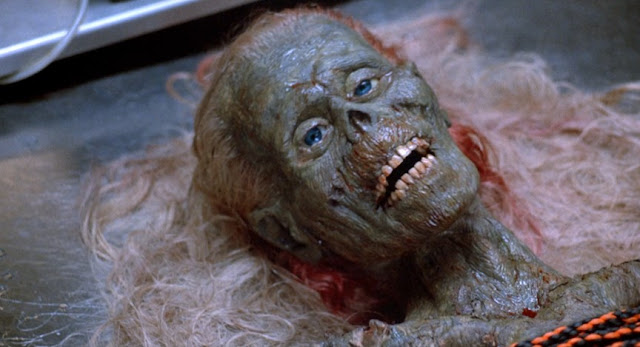
I wanted to hate Zack Snyder's Dawn of the Dead merely on principle.
The brand new remake train had barely been rolling before one of the grandaddy of all zombie horror classics was announced: George A. Romero’s seminal semi-sequel Dawn of the Dead.
The jaws of horror fans everywhere dropped like a ‘70s Tom Savini over a mall banister.
“How dare they?”
By now, the remake of The Texas Chain Saw Massacre had come and gone, leaving behind a relatively positive reaction on audiences and a wildly successful profit. If that was to be the beginning of a remake craze that still hasn't gone away, no one at that moment would know. But when Dawn was announced, Internet considered rioting in the streets before deciding to just stay home and bitch about it on Internet. And, if we’re being fair, the earliest snippets of preliminary information re: Dawn proceeded through the usual rank-and-file motions that most remakes would follow — an untested music video director would helm; there’d be no involvement from its original writer or director; the cast would be relatively obscure (including a then-unknown Ty Burrell).
Oh, and the guy who wrote the Freddie Prinze Jr. Scooby Doo movies was handling the screenplay.
: O

But a funny thing happened: Dawn of the Dead proved not only to be the best 2000s era remake to come down the pike, but it transcended all the remake baggage to become an excellent, vicious, dark (and light) contribution to the horror genre.
The aforementioned screenplay by that Scooby Doo guy (James Gunn, who would go on to write and direct the beloved Guardians of the Galaxy flicks for Marvel) was undeniably clever and whip-smart, and which included cameos from a large portion of the original’s cast. (Ken Foree even gets to recite his infamous line of dialogue — “When there’s no more room in Hell, the dead will walk the earth.” — now with a much bleaker approach.) Even the character of Andy, the gun store owner who has been living on the roof of his store, and who communicates back and forth with our cast via dry erase boards and binoculars, was extremely well utilized, offering an atypical but effective relationship that you’d hope to see in these kinds of films where characterization sometimes falls by the wayside. (And the conclusion of his character is eerie as hell.) The screenplay lacks the commercialism subtext from the original, but as confirmed by participants this wasn’t by accident. Gunn, especially, felt Romero had already done it, and didn’t feel the need to do it again.
Signs of the Zack Snyder to come are present, but still dialed back, offering a sense of a filmmaker establishing a style and oeuvre that would be on more prominent display in 300 and The Watchmen. Though Dawn is incredibly gory in spots, the action elements are rousing and intense; Dawn’s entire first and third acts are nothing but mounting tension and propulsive fight-or-flight scenes, filled with an incredible array of gore gags.

The cast work well as an ensemble, with the only minor weak spot being Sarah Polley, who doesn’t seem entirely comfortable working in such a specific genre. She’s just fine in the smaller moments, especially when we see the adrenaline melt off following the harrowing opening escape scene and letting the reality sink in, leaving her a sobbing mess. But in the bigger, more genre-appropriate moments, she’s not nearly as convincing. Ving Rhames enjoys a more prominent role here than he was getting during this era of his career, playing the prototypical Snake Plissken-ish bad-ass who abides by his rules exclusively, but he’s good at this type of role and easily embodies the kind of part essayed by Ken Foree in the original. (With a clear intent on being deceiving, director Steve Miner cast Rhames as a similarly bad-ass military man in his woeful remake of Day of the Dead in an effort to suggest the two films were related. They aren’t.) A pre-House of Cards Michael Kelly plays C.J., the asshole security guard with a heart of gold who ultimately ends up playing the film’s most interesting character, and the actor subsequently offers the absolute best performance in the entire cast.
Dawn of the Dead shouldn’t be as good as it is, and even if Zack Snyder had gone on to do nothing else notable for the remainder of his career (you’d probably have people out there who would confirm this), he at least proved there is such a thing as doing a good remake, and laying out how to do it: respect the original and its fans, take the concept and do something familiar but new, and leave it all out on the field. (Plus a Tom Savini cameo never hurts.)




















